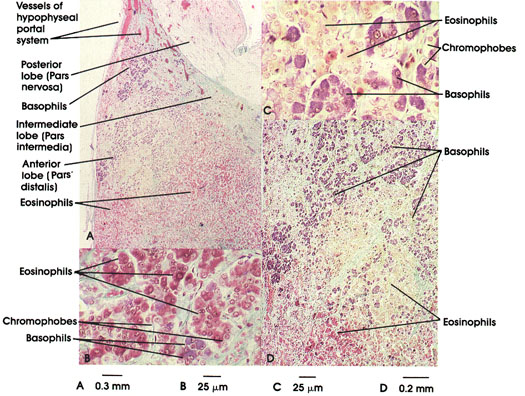

Plate 15.280 Hypophysis Cerebri
Ronald A. Bergman, Ph.D., Adel K. Afifi, M.D., Paul M. Heidger,
Jr., Ph.D.
Peer Review Status: Externally Peer Reviewed

Human, Susa, AFT,
A. 32 x, B. 316 x, C. 316 x D. 82 x.
This plate is at higher magnification than the preceding one. This permits easier location and identification of various cell types that populate the pituitary gland. One may find three cell types grouped under two headings: (1) chromophils, which include eosinophils (two types in this preparation) and basophils, and (2) chromophobes.
it must be remembered that empirical histological methods cannot differentiate precisely cell types. This can now be done by immunocytochernistry, but this method effaces other structural detail; therefore, several methods are usually required. Students interested in the complexities of cell typing should consult recent original investigative references. Nevertheless, one can locate populations of cells whose functions can be ascribed because they bear consistent staining characteristics.
Eosinophils are of two types and are known to secrete growth hormone (somatotropin) and prolactin. Both cells are stainable with orange G, but not with the periodic acid-Schiff method.
Basophils fall into three types: one type produces follicle-stimulating hormone (FSH) and luteinizing hormone (LH); a second type produces thyrotropic hormone; and a third type produces adrenocorticotropic (ACTH) hormone. These cells do not stain with orange G but do stain with the periodic acid-Schiff method, reflecting the glycoprotein, rather than any acid, nature of the synthesized secretory product.
Some chromophobes may be supporting cells with long branching processes forming a network within the parenchyma of the organ. Other chromophobe cells are not numerous and may be either transitionally degranulated cells or may be considered as reserve cells.
The pituitary gland receives its blood supply from the internal carotid artery and the superior and inferior hypophyseal arteries. The superior artery becomes a primary capillary plexus with fenestrated capillaries. Neurosecretory neurons contain releasing or inhibitory factors and are intimately associated with the capillary plexuses. These capillary plexuses rejoin to form portal (vessels located between and joining two capillary beds) veins, which once again form capillary plexuses around cells of the adenohypophysis (pars distalis). It can be appreciated that this system is critically important to normal hypophyseal function.
Pituicyte nuclei: The pituicyte perikaryon is not seen. These cells constitute 25 to 30 percent of the posterior lobe of the hypophysis. Function is poorly understood. Pituicytes are related to the neurosecretory axons and they correspond to neuroglia of the brain.
Capillary: Capillaries receive hormones secreted from Herring* bodies for distribution throughout the body. The posterior lobe of the hypophysis is highly vascularized.
*Herring was a nineteenth-century English physiologist.
Next Page | Previous Page | Section Top | Title Page
Please send us comments by filling out our Comment Form.
All contents copyright © 1995-2025 the Author(s) and Michael P. D'Alessandro, M.D. All rights reserved.
"Anatomy Atlases", the Anatomy Atlases logo, and "A digital library of anatomy information" are all Trademarks of Michael P. D'Alessandro, M.D.
Anatomy Atlases is funded in whole by Michael P. D'Alessandro, M.D. Advertising is not accepted.
Your personal information remains confidential and is not sold, leased, or given to any third party be they reliable or not.
The information contained in Anatomy Atlases is not a substitute for the medical care and advice of your physician. There may be variations in treatment that your physician may recommend based on individual facts and circumstances.
URL: http://www.anatomyatlases.org/